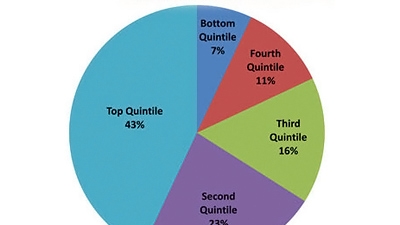The biggest beneficiaries of fossil fuel subsidies are not the poor. In fact, studies show that many subsidies are regressive in nature.
A recent IMF study of fossil fuel subsidies globally determined that the wealthiest 20 percent of the population gets a disproportionate 43 percent of the benefit from fossil fuel subsidies, while the poorest 20 percent gets only 7 percent. In fact, the poorest 60 percent of the population still doesn't get as much benefit as the wealthiest quintile.
According to a compilation of estimates by international organizations, consumption subsidies reached US$1 trillion to US$1.2 trillion worldwide, consistent with McKinsey & Company's estimate of US$1.1 trillion. Those costs include:
- Fossil fuel subsidies: Estimated to cost between US$455 billion and US$485 billion.
- Water subsidies: Estimated at between US$200 billion and US$300 billion.
- Fisheries subsidies: Estimated at between US$10 billion and US$30 billion.
There are better ways to provide assistance to the people who need it most that are also less expensive for the national budget.
By one estimate, the cost of transferring US$1 to the poorest 20 percent of the population via gasoline subsidies is US$33. If countries instead shifted that funding to targeted support for the poor, the funding would help the people who need it most, rather than those who need it least.
Similarly, consumption subsidies for water and electricity can be replaced by connection subsidies that are better targeted, since the poor account for the majority of those without access to basic services.
Consumption subsidies exacerbate common-property problems. Global subsidies to fisheries, for example, are partly to blame for the sixfold increase in the fleet capacity index between 1970 and 2005. In Mexico, subsidies for energy used in irrigation, amounting to around 1 percent of GDP, are exacerbating excessive groundwater withdrawals and the depletion of key aquifers. India suffers from the same problem in addition to spending some 2 percent of GDP on a fertilizer subsidy overly weighted in favor of nitrogen; the resulting use of fertilizer is causing serious pollution problems.
Morocco's Experience
With a sound understanding of the winners and losers of possible green growth strategies, policy makers can find ways to address tough economic reforms — as Morocco has found in its quest to overhaul a universal subsidy system that rewards fossil fuel consumption.
The problems with Morocco’s energy subsidy are multiple. Its fiscal impact reached 5.5 percent of GDP in 2011, absorbing roughly 17 percent of the total investment budget. It undercuts Morocco’s ambitious mitigation goals by keeping the price of fossil-based energy products low, making renewable and efficiency investments less competitive. And it is regressive, with the wealthy benefitting the most.
The government conducted a survey in 2010 to see how subsidies were perceived among the population. The survey found that more than 70 percent of the population was unaware of the existence of energy subsidies. The vast majority of buyers of 12 liter cooking gas bottles—a product as widespread as bread—did not know that the real market price was more than DH 100 (US$14) instead of the standard retail price of DH 40 (US$5.6).
When first asked, a large majority opposed the idea of reducing subsidies. This majority decreased when a well-targeted social program was suggested as an alternative, and it fell even further when the program was explained in detail. In the end, it was the wealthy that remained the group most opposed to reform.
The findings helped the government develop a communication strategy over the medium term, starting from informing the population of the existence of the subsidy system and explaining its disadvantages. The government elected in November 2011 now has energy subsidy reform at the top of its agenda.
By gaining insights into the political economy of reform, Morocco is now poised to sharply reduce fiscal costs and facilitate a greener growth path.

